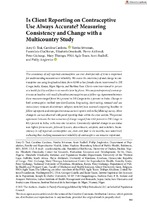| dc.contributor.author | Tsui, Amy O. | |
| dc.contributor.author | Cardona, Carolina | |
| dc.contributor.author | Srivatsan, Varsha | |
| dc.date.accessioned | 2021-09-22T08:47:14Z | |
| dc.date.available | 2021-09-22T08:47:14Z | |
| dc.date.issued | 2021 | |
| dc.identifier.citation | Tsui, A. O., Cardona, C., Srivatsan, V., OlaOlorun, F., Omoluabi, E., Akilimali, P., Gichangi, P., Thiongo, M., Radloff, S., & Anglewicz, P. (2021). Is client reporting on contraceptive use always accurate? measuring consistency and change with a multicountry study. studies in family planning, 52(3), 361–382. https://doi.org/10.1111/sifp.12172 | en_US |
| dc.identifier.uri | doi.org/10.1111/sifp.12172 | |
| dc.identifier.uri | http://hdl.handle.net/10566/6753 | |
| dc.description.abstract | The consistency of self-reported contraceptive use over short periods of time is important for understanding measurement reliability. We assess the consistency of and change in contraceptive use using longitudinal data from 9,390 urban female clients interviewed in DR Congo, India, Kenya, Niger, Nigeria, and Burkina Faso. Clients were interviewed in-person at a health facility and four to six months later by phone. We compared reports of contraceptive use at baseline with recall of baseline contraceptive use at follow-up. Agreement between these measures ranged from 59.1 percent in DR Congo to 84.4 percent in India. Change in both contraceptive method type (sterilization, long-acting, short-acting, nonuse) and use status (user, nonuser, discontinuer, adopter, switcher) was assessed comparing baseline to follow-up reports and retrospective versus current reports within the follow-up survey. More change in use was observed with panel reporting than within the cross section. The percent agreement between the two scenarios of change ranged from 64.8 percent in DR Congo to 84.5 percent in India, with cross-site variation. Consistently reported change in use status was highest for nonusers, followed by users, discontinuers, adopters, and switchers. Inconsistency in self-reported contraceptive use, even over four to six months, was nontrivial, indicating that studying measurement reliability of contraceptive use remains important. | en_US |
| dc.language.iso | en | en_US |
| dc.publisher | Studies in Family Planning | en_US |
| dc.subject | contraceptive use | en_US |
| dc.subject | longitudinal data | en_US |
| dc.subject | urban female | en_US |
| dc.subject | DR Congo | en_US |
| dc.subject | India | en_US |
| dc.subject | Kenya | en_US |
| dc.subject | Nigeria | en_US |
| dc.subject | Burkina Faso | en_US |
| dc.title | Is client reporting on contraceptive use always accurate?measuring consistency and Change with a multicountry study | en_US |
| dc.type | Article | en_US |

